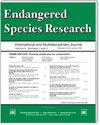Videographic monitoring at caves to estimate population size of the endangered yǻyaguak (Mariana swiftlet) on Guam
IF 2.9
2区 环境科学与生态学
Q2 BIODIVERSITY CONSERVATION
引用次数: 0
Abstract
ABSTRACT: The yǻyaguak (Mariana swiftlet; Aerodramus bartschi) is an endangered cave-nesting species historically found on Guam and the southern Mariana Islands, Micronesia. The population on Guam has been severely affected by the introduction of the brown treesnake Boiga irregularis. Population status assessments have, however, been challenging due to the limitations of traditional counting methods, which rely on visual observations at cave entrances and are prone to inaccuracies. To improve count accuracy, we estimated yǻyaguak population size and relative nesting activity using thermal and near-infrared videography. The population on Guam was surveyed at the island’s 3 known occupied caves (Mahlac, Maemong, and Fachi) between 2019 and 2023. Mahlac Cave harbored the largest colony, which ranged from 506 to 665 birds; Maemong Cave held 144 to 196 birds; and Fachi Cave, which is sometimes flooded, had 28 (in 2019) and 35 birds (in 2023). Our estimates indicate a slight decline in the yǻyaguak population over the study period. This study demonstrates the potential of thermal and near-infrared videography for improved monitoring of yǻyaguak colonies and nesting activity, which will contribute to our understanding of population dynamics and the effectiveness of management strategies such as brown treesnake control.通过洞穴录像监测估算关岛濒危 "ǻyaguak"(马里亚纳金丝燕)的种群数量
摘要:ǻyaguak(马里亚纳金丝燕;Aerodramus bartschi)是一种濒危洞穴筑巢物种,历史上曾在关岛和密克罗尼西亚马里亚纳群岛南部发现。关岛的金丝燕种群受到引进的棕色树蛇(Boiga irregularis)的严重影响。然而,由于传统的计数方法依赖于洞穴入口处的肉眼观察,容易出现误差,因此对其种群状况的评估具有挑战性。为了提高计数的准确性,我们使用热成像和近红外摄像技术估算了ǻyyaguak的种群数量和相对筑巢活动。在2019年至2023年期间,我们在关岛3个已知有人居住的洞穴(Mahlac、Maemong和Fachi)调查了关岛的种群数量。Mahlac洞穴拥有最大的鸟群,数量从506只到665只不等;Maemong洞穴拥有144只到196只鸟;Fachi洞穴有时会被洪水淹没,拥有28只鸟(2019年)和35只鸟(2023年)。我们的估计表明,ǻyaguak 的数量在研究期间略有下降。这项研究证明了热成像和近红外摄像技术在改善对ǻyaguak 群落和筑巢活动的监测方面的潜力,这将有助于我们了解种群动态和管理策略的有效性,如褐树蛇控制。
本文章由计算机程序翻译,如有差异,请以英文原文为准。
求助全文
约1分钟内获得全文
求助全文
来源期刊

Endangered Species Research
BIODIVERSITY CONSERVATION-
CiteScore
5.50
自引率
6.50%
发文量
38
审稿时长
31 weeks
期刊介绍:
ESR is international and interdisciplinary. It covers all endangered forms of life on Earth, the threats faced by species and their habitats and the necessary steps that must be undertaken to ensure their conservation. ESR publishes high quality contributions reporting research on all species (and habitats) of conservation concern, whether they be classified as Near Threatened or Threatened (Endangered or Vulnerable) by the International Union for the Conservation of Nature and Natural Resources (IUCN) or highlighted as part of national or regional conservation strategies. Submissions on all aspects of conservation science are welcome.
 求助内容:
求助内容: 应助结果提醒方式:
应助结果提醒方式:


